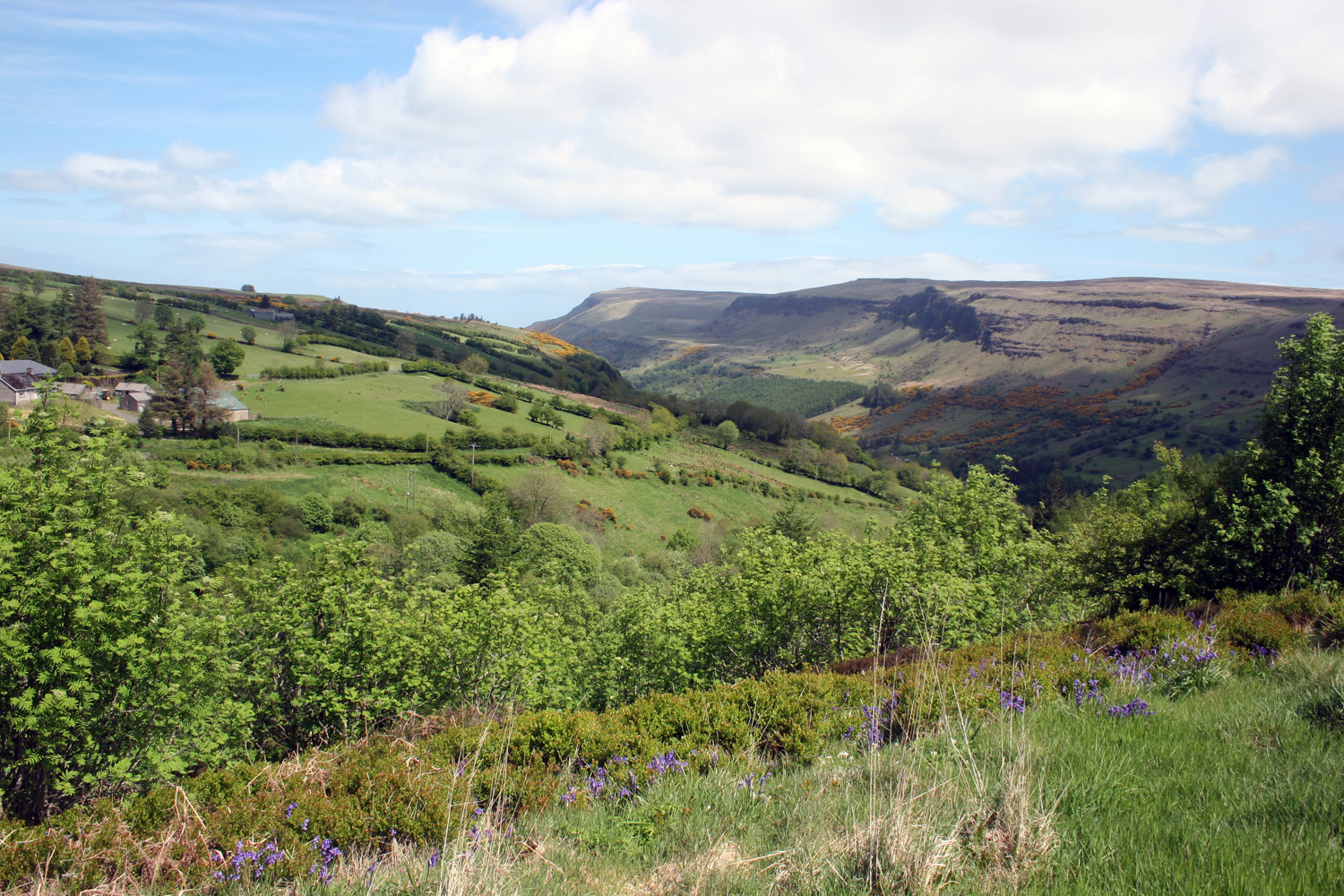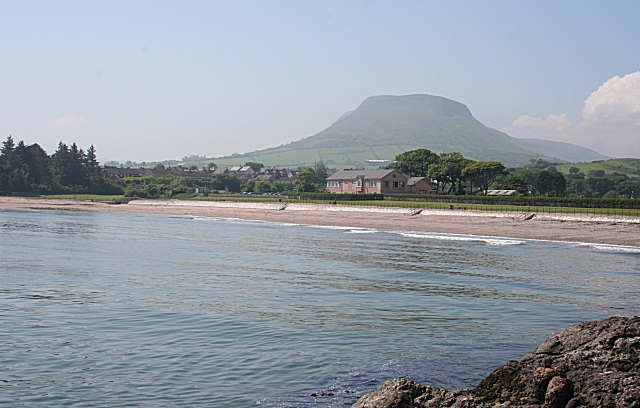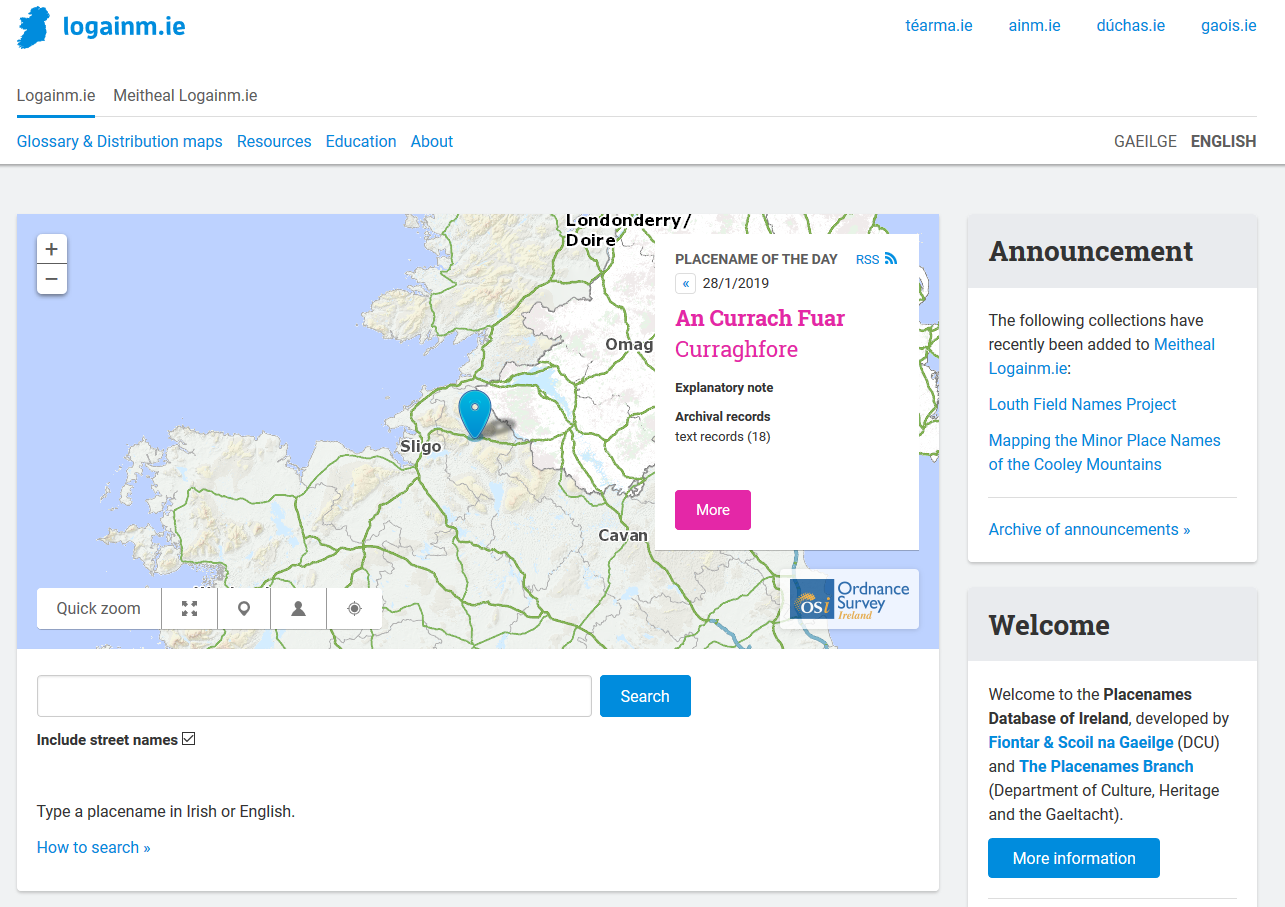|
Cushendun
Cushendun () is a small coastal village in County Antrim, Northern Ireland. It sits off the A2 coast road between Cushendall and Ballycastle. It has a sheltered harbour and lies at the mouth of the River Dun and Glendun, one of the nine Glens of Antrim. The Mull of Kintyre in Scotland is only about 15 miles away across the North Channel and can be seen easily on clear days. In the 2001 census it had a population of 138 people. It is part of Causeway Coast and Glens district. The hamlet of Knocknacarry is nearby. History Four miles north of Cushendun is the carnanmore passage cairn. This well-preserved cairn is located on a hilltop, is 75 feet in length and is visible is for miles. The chamber has a corbelled roof and is capped with a massive stone slab. Two stones are decorated with lozenges and spirals. Cushendun is where Shane O'Neill, chief of the Tyrone O'Neill dynasty, was killed by the MacDonnells in 1567. Cushendun village was designed for Ronald McNeill, t ... [...More Info...] [...Related Items...] OR: [Wikipedia] [Google] [Baidu] |
Ronald McNeill, 1st Baron Cushendun
Ronald John McNeill, 1st Baron Cushendun, PC (30 April 1861 – 12 October 1934), was a British Conservative politician and writer. Background and education McNeill was born in Torquay. He was the son of Edmund McNeill, DL, JP and Sheriff of County Antrim, and his wife Mary (née Miller). He was educated at Harrow and Christ Church, Oxford, graduating in 1886. McNeill was called to the bar in 1888 and started work as editor of ''The St James's Gazette'' (1900–04), as well as assistant editor of the ''Encyclopædia Britannica'' (1906–10). Political career Having unsuccessfully contested the seats of West Aberdeenshire (1906), Aberdeen South (1907 and Jan. 1910) and Kirkcudbrightshire (Dec. 1910), McNeill was elected as Unionist Member of Parliament for the St Augustine's division of Kent in 1911. Seven years later he became representative for Canterbury and in 1922 was appointed Under-Secretary of State for Foreign Affairs, a post he held, with a short interval for ... [...More Info...] [...Related Items...] OR: [Wikipedia] [Google] [Baidu] |
Clough Williams-Ellis
Sir Bertram Clough Williams-Ellis, Order of the British Empire, CBE, Military Cross, MC (28 May 1883 – 9 April 1978) was a Welsh architect known chiefly as the creator of the Italianate architecture, Italianate village of Portmeirion in North Wales. He became a major figure in the development of Welsh architecture in the first half of the 20th century, in a variety of styles and building types. Early life Clough Williams-Ellis was born in Gayton, Northamptonshire, England, but his family moved back to his father's native North Wales when he was four. The family have strong Welsh roots and Clough Williams-Ellis claimed direct descent from Owain Gwynedd, Prince of North Wales. His father John Clough Williams Ellis (1833–1913) was a clergyman and noted mountaineer while his mother Ellen Mabel Greaves (1851–1941) was the daughter of the slate mine proprietor John Whitehead Greaves and sister of John Ernest Greaves. He was educated at Oundle School in Northamptonshire. Though ... [...More Info...] [...Related Items...] OR: [Wikipedia] [Google] [Baidu] |
Shane O'Neill (Irish Chieftain)
Shane O'Neill (; 1530 – 2 June 1567) was an Irish chieftain of the O'Neill dynasty of Ulster in the mid-16th century. Shane O'Neill's career was marked by his ambition to be the O'Neill—sovereign of the dominant O'Neill family of Tír Eoghain. This brought him into conflict with competing branches of the O'Neill family and with the English government in Ireland, who recognised a rival claim. Shane's support was considered worth gaining by the English even during the lifetime of his father Conn O'Neill, 1st Earl of Tyrone (died 1559). But rejecting overtures from the 3rd Earl of Sussex, the lord deputy from 1556, Shane refused to help the English against the Scottish settlers on the coast of Antrim, allying himself for a short time instead with the MacDonnells, the most powerful of these settlers. Shane viewed the Scottish settlers as invaders, but decided to stay his hand against them with hopes of using them to strengthen his position with the English. However, tension ... [...More Info...] [...Related Items...] OR: [Wikipedia] [Google] [Baidu] |
Knocknacarry
Knocknacarry ( ; – referring to a weir diverted off the River Dun which operated a watermill) is a hamlet and townland (of 155 acres) about 1 kilometre west of Cushendun and 17 kilometres south-east of Ballycastle in County Antrim, Northern Ireland. It is situated in the historic barony of Glenarm Lower and the civil parish of Layd. In the 2001 Census it had a population of 138 people. It is within the Causeway Coast and Glens Borough Council area. Knocknacarry lies within the Antrim Coast and Glens Area of Outstanding Natural Beauty, designated in 1988. St. Ciaran's Primary School, which also serves the village of Cushendun and the wider local area, is in Knocknacarry. The river bed of the River Dun at Knocknacarry Bridge, north of Knocknacarry, is of scientific interest in the field of mineralogy and an example of Cushendun Granite. References NI Neighbourhood Information System External links Photo: Entering the village of Knocknacarry from the south-west ... [...More Info...] [...Related Items...] OR: [Wikipedia] [Google] [Baidu] |
River Dun, Northern Ireland
The River Dun, also known as the Glendun River (in Irish: ''Abhann Duinne'', brown river) is a river in County Antrim, Northern Ireland. It runs through Glendun, one of the nine Glens of Antrim. The river is named after its brown colour, which comes from the peat bogs at its source on the slopes of Slievenanee on the Antrim Plateau. The source of the river is a few hundred metres from that of the River Bush, which flows north-east to meet the sea at Bushmills. Cushendun (''Bun Abhann Duinne'', "foot of the River Dun" in Irish – although the English name derives from ''Cois Abhann Duinne'', "beside the River Dun") is a small coastal resort town lying at the mouth of the River Dun and Glendun. Glendun Viaduct The river is spanned by the Glendun Viaduct. The arched viaduct, known locally as the Big Bridge, was built between 1834 and 1839 by workers from County Monaghan and County Donegal. Angling The river supports a population of brown trout which rarely attain wei ... [...More Info...] [...Related Items...] OR: [Wikipedia] [Google] [Baidu] |
Causeway Coast And Glens
Causeway Coast and Glens is a local government district covering most of the northern part of Northern Ireland. It was created on 1 April 2015 by merging the Borough of Ballymoney, the Borough of Coleraine, the Borough of Limavady and the District of Moyle. The local authority is Causeway Coast and Glens Borough Council. Geography The district covers most of the northern part of Northern Ireland; an area totalling 1796 km2 spanning parts of Counties Antrim and Londonderry. It had a population of around in . The name of the new district was announced on 17 September 2008 as 'Causeway Coast' and was revised in February 2009. Northern Ireland Railways stations * Bellarena station * Castlerock station * Coleraine station *Ballymoney * University station * Dhu Varren station * Portrush station Rail services NI Railways provides services on the Belfast-Derry railway line between Derry~Londonderry station in the west and east to Belfast Lanyon Place station and Belfas ... [...More Info...] [...Related Items...] OR: [Wikipedia] [Google] [Baidu] |
County Antrim
County Antrim (named after the town of Antrim, County Antrim, Antrim, ) is one of the six counties of Northern Ireland, located within the historic Provinces of Ireland, province of Ulster. Adjoined to the north-east shore of Lough Neagh, the county covers an area of and has a population of 651,321, as of the 2021 United Kingdom census, 2021 census. County Antrim has a population density of 211 people per square kilometre or 546 people per square mile. It is also one of the thirty-two traditional Counties of Ireland, counties of Ireland. The Glens of Antrim offer isolated rugged landscapes, the Giant's Causeway is a unique landscape and a UNESCO World Heritage Site, Bushmills, County Antrim, Bushmills produces whiskey, and Portrush is a popular seaside resort and night-life area. The majority of Belfast, the capital city of Northern Ireland, is in County Antrim, with the remainder being in County Down. According to the United Kingdom Census 2001, 2001, United Kingdom Census 20 ... [...More Info...] [...Related Items...] OR: [Wikipedia] [Google] [Baidu] |
Glens Of Antrim
The Glens of Antrim ( Irish: ''Glinnte Aontroma''), known locally as simply The Glens, is a region of County Antrim, Northern Ireland. It comprises nine glens, that radiate from the Antrim Plateau to the coast. The Glens are an area of outstanding natural beauty and are a major tourist attraction in north Antrim. The main towns and villages in the Glens are Ballycastle, Cushendun, Cushendall, Waterfoot, Carnlough and Glenarm. The Lordship of the Glens From the mid-13th century onward, the Lordship of The Glens belonged to the Bissett family, Anglo-Norman in origin but Gaelicized over generations. With the marriage of John Mor Macdonald, second son of John of Islay, Lord of the Isles, to Margery Bisset in the late 14th century, the Glens came into the ownership of the MacDonnells of Antrim. John Mor gained the title Lord of Dunyvaig and the Glens. The nine glens From north to south, the nine glens are: Tenth glen Glenravel is sometimes referred to as a tenth glen b ... [...More Info...] [...Related Items...] OR: [Wikipedia] [Google] [Baidu] |
Glendun
Glendun (in Irish: ''Gleann Abhann Duinne'') translates into English as ''glen of the brown river'' and is one of the nine Glens of Antrim in County Antrim in Northern Ireland. It is named after the River Dun which is coloured brown by the peat bogs at the river source. Like all glens in that area, it was shaped during the Ice Age by giant glaciers. The village of Cushendun and the hamlet of Knocknacarry Knocknacarry ( ; – referring to a weir diverted off the River Dun which operated a watermill) is a hamlet and townland (of 155 acres) about 1 kilometre west of Cushendun and 17 kilometres south-east of Ballycastle in County Antrim, Norther ... both lie at the foot of the glen. External linksGlens of Antrim Website G ... [...More Info...] [...Related Items...] OR: [Wikipedia] [Google] [Baidu] |
Cushendall
Cushendall (), formerly known as Newtownglens, is a coastal village and townland (of 153 acres) in County Antrim, Northern Ireland. It is located in the historic barony of Glenarm Lower and the civil parish of Layd, and is part of Causeway Coast and Glens district. Located on the A2 coast road between Glenariff and Cushendun, Cushendall is in the Antrim Coast and Glens an Area of Outstanding Natural Beauty. It lies in the shadow of the table topped Lurigethan Mountain and at the meeting point of three of the Glens of Antrim: Glenaan, Glenballyemon and Glencorp. This part of the Northern Irish coastline is separated from Scotland by the North Channel, with the Mull of Kintyre about 16 miles away. In the 2011 Census, Cushendall had a population of 1,280 people. This article contains quotations from this source, which is available under thOpen Government Licence v3.0 © Crown copyright. Much of the historic character of the 19th century settlement on the north bank of the Rive ... [...More Info...] [...Related Items...] OR: [Wikipedia] [Google] [Baidu] |
Chambered Grave On Carnanmore - Geograph
Chambered is an adjective related to the word chamber. It may refer to: * Chambered body, an element of some electric guitars * Chambered cairn or Chambered long barrow, types of megalithic burial monument * Chambered nautilus (''Nautilus pompilius''), the best-known species of nautilus * Chambered stinkhorn (''Lysurus periphragmoides''), a species of fungus * Three chambered heart or Four chambered heart, types of hearts * The Four-Chambered Heart ''The Four-Chambered Heart'' is a 1950 autobiographical novel by France, French-born writer Anaïs Nin, part of her ''Cities of the Interior'' sequence. It is about a woman named Djuna, her love, her thoughts, her emotions, her doubts, her decisi ..., a 1950 autobiographical novel See also * Camerata (other), the Latin equivalent of the word {{disambiguation ... [...More Info...] [...Related Items...] OR: [Wikipedia] [Google] [Baidu] |
Placenames Database Of Ireland
The Placenames Database of Ireland (), also known as , is a database and archive of place names in Ireland. It was created by Fiontar, Dublin City University in collaboration with the Placenames Branch of the Department of Tourism, Culture, Arts, Gaeltacht, Sport and Media. The website is a public resource primarily aimed at journalists and translators, students and teachers, historians and researchers in genealogy. Placenames Commission and Placenames Branch The Placenames Commission () was established by the Department of Finance in 1946 to advise Ordnance Survey Ireland and the government of what the Irish name of places should be. Although both the 1922 Constitution of the Irish Free State and the current constitution adopted in 1937 recognised Irish as the national language, the law in regard to placenames was carried over from the 19th-century UK statutes which established the Ordnance Survey and Griffith's Valuation, under which only an English-language name had offi ... [...More Info...] [...Related Items...] OR: [Wikipedia] [Google] [Baidu] |





